Lexus did something daring when it redesigned the LS – its top-of-the-line luxury sedan.
It gave it an engine the same size as a Camry’s – Toyota’s mid-sized family sedan. And no longer offers the LS with anything bigger than the Camry’s V6.
But sometimes, size doesn’t matter.
Horsepower – and torque – does.
The LS500 is Lexus’ largest, most opulent – and powerful – sedan. It is also the sedan that established Lexus, way back in the late ’80s, as Toyota’s Luxury division – and a more-than-credible rival to German luxury brands such as Mercedes-Benz, BMW and Audi – by undercutting them on price without compromising anything.
That tradition continues with the new LS.
Its standard 3.5 liter V6 is much stronger than the V8 the LS came standard with previously.
It’s also stronger than the six cylinder engines that come standard in its two other rivals, the Audi A8 and BMW 7 Series.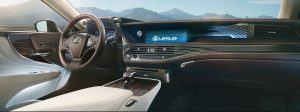
And it’s also almost as strong as the optional V8 in the Mercedes-Benz S-Class, one of its primary rivals.
The LS is also a deal.
Lexus asks $75,300 to start for the LS500 with rear-wheel-drive; $78,520 with the optional all-wheel-drive system.
$84,520 for a top-of-the-line F-Sport with AWD – which also gets an upgraded brake/wheel/tire package, 28-way power seats with pneumatic side bolsters that brace you during cornering and Naguri brushed aluminum trim upgrades.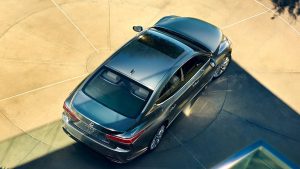
The S-Class Benz offers pneumatic side bolsters but starts at $89,900 – without AWD (or V8).
The Audi A8, which is also fresh off the page this year, comes standard with AWD – but no more than 369 hp (vs. 416 for the Lexus) and begins at $83,800.
You can get a 443 hp V8 in the BMW 7 Series . . . for $96,950. Adding AWD gets you to within $50 of six figures ($99,950).
Lexus has value in its favor as well as power.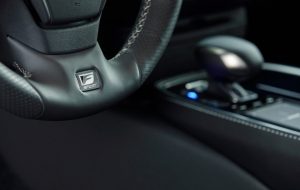
It also offers unique tech – such as the available 24 inch Heads Up Display (HUD) – and amenities such as the Executive Package’s Kiriko Glass trim, which emulates a type of traditional hand-cut Japanese glassware.
But the real value is the holding of it.
Luxury cars bleed value like a gut shot hemophiliac – some of them losing half their original value before they’re five years old. Lexus cars depreciate, too – but at a gentler pace. This has been one of the brand’s major strengths over the years and remains one today.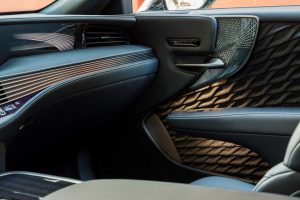
What’s New
Amazon Alexa is now available as a factory option – it’s integrated with the LS500’s Enform concierge system.
You can use it to send commands to your Alexa at home – such as turn off the lights, adjust the thermostat and so on. The in-car Alexa can sync with the GPS system, too – and provide “on the go” recommendations about such things as nearby attractions, restaurants and so on.
A new white interior scheme is also available with the Mark Levinson package; also 20-inch “Vapor Chrome” wheels, with the Executive package.
Long wheelbase (and more room) is now standard.
More than old V8 power from now-standard twin-turbo V6.
A better deal up front and down the road.
What’s Not So Good
AppleCarPlay is standard – but AndroidAuto isn’t available.
F Sport upgrades don’t include a horsepower upgrade.
Road Sign Assist is a creepy harbinger of Intelligent Speed Assist (more here).
Lexus takes the position that a top-of-the-line luxury sedan shouldn’t come with less than a top-of-the-line engine. Accordingly, all LS500s, regardless of trim, come standard with a new twin-turbo 3.5 liter V6 that makes more horsepower (416) than all three of its major rival’s standard engines.
And more than some of them even offer.
It also makes an astounding 442 ft.-lbs. of torque at just 1,600 RPM – which is more than most V8s deliver – and definitely sooner.
Which explains the near-miracle of the nearly 5,000-lb. LS500’s 4.6 second to 60 capability.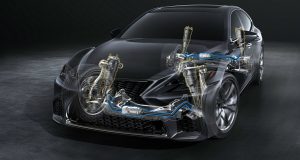
That’s a solid second quicker to 60 than the previous, V8-powered LS.
Its much larger 4.6 liter V8 only made 386 horsepower and a mere 347 ft.-lbs. of torque at 4,100 RPM.
A ten speed automatic transmission backs up the new twice-turbo’d V6 – vs. the eight-speed automatic that was paired with the retired V8. This helps account for the LS500’s pretty spectacular mileage – 19 city, 30 highway for the rear-drive version (18 city, 27 with AWD) vs. 16 city, 24 highway for the put-to-pasture V8.
To put it in context, the almost-Tahoe heavy LS manages to get within 2 MPG of the highway mileage achieved by the much smaller, much less heavy – and far less powerful Camry V6 (32 MPG).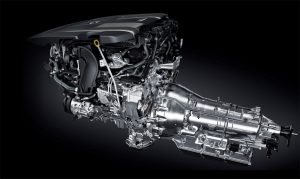
The also-new ten speed tranny – not Caitlyn – has three overdrive ratios, with the final one (10th gear) being an astounding .598 ratio. This cuts cruise revs at 60 or so to about 1,800.
Leverage is our friend.
So also displacement on demand – which is basically what turbocharging amounts to. The small V6 becomes bigger than a V8 when the turbos come online and pressurize the cylinders, stuffing them with more air than they could otherwise gulp on their own.
Boom, 416 hp – and all that torque, too.
When off boost, the mileage goes up.
Interestingly, both BMW and Audi also turbo their standard sixes, but the resultant output isn’t competitive with the output of the LS’s six. The BMW 7’s standard 3.0 liter six maxes out at 335 hp; the Audi A8’s also 3.0 six does better than the BMW – 369 hp – but both are distant second and third place on output vs. the Lexus, which wouldn’t be objectionable if they cost less than the LS.
Tech tidbit: The LS500’s V6 has both direct and port fuel injection. DI – to help make the power and boost the mileage and PFI (dedicated circuit) to keep the backsides of the intake valves from becoming encrusted with carbon. Which they tend to do in direct-injected engines because there’s no solvent effect of gas washing the carbon off the valves because the fuel is sprayed directly into each cylinder, rather than spritzed in from above them.
Lexus doesn’t advertise the PFI piggyback but should – because it fixes a potentially expensive problem with direct-injected engines.
See that part about Lexus vehicles holding value.
It’s hard to say whether it is more enjoyable to drive the LS500 – or be taken for a ride in one. The back seat – which can be ordered with a recliner and an ottoman for your feet as well as massagers for your back – is just as much a treat as the driver’s seat.
They really ought to put a liveried driver on the options list. And they almost have (more on this below).
There is sport here, too – not just ultra-luxury.
Lexus has lowered the ride height by almost an inch vs. the previous generation LS and – if you order the F-Sport – you can get very aggressive staggered-size “summer” tires on 20 inch wheels, which help this full-size luxury liner carve corners almost as athletically as sports cars half its size.
And half its weight.
Which is close to what some full-size SUVs weigh. Which is also what you want if you crave the feeling of being protected from the sans culottes as well as from the vagaries of crumbling infrastructure.
If you buy the optional AWD system, you’ll get a rear-biased system – which is a good thing from the standpoint of handling/cornering feel. Lexus says the power split is usually weighted 60 percent to the rear wheels and 31 percent to the front wheels but can transition to almost 50-50 (48-52) on slick surfaces.
Speaking of things to the rear . . . F Sports can be ordered with a rear wheel steering (DRS) system, which automatically coordinates with the directional inputs of the front wheels to correct for understeer/oversteer. Most cars rely on selective application of brake/throttle to achieve the same, but Lexus says the advantage to its system is invisibility.
The corrective action of braking (and cutting throttle) often isn’t. You feel a stumble – as the throttle is cut back by the car’s computer – or a little drag – as the brakes are pumped.
Turning circle varies depending on whether you go RWD (18.7 feet) or AWD (19.7 feet) either of which is fairly tight for such a big – and long – car. For reference, the BMW 7’s turning circle is about 21 feet.
The current Benz S-Class sedan’s is just under 20 feet.
The LS – like others in this class – comes with everything short of fully automated driving tech. It can change lanes on its own, maintain course, stop and accelerate – without any input from the driver.
The voice-recognition system, however, isn’t as sophisticated as the latest Mercedes system, which allows almost all of the car’s infotainment equipment to be controlled without touching (or tapping/swiping/pinching/scrolling) anything.
Fifty is the new 35.
Or 40, anyhow.
The people who buy cars like the LS are – almost by default – older buyers. It takes time to generate the cashflow to buy a car like this. But today’s 40-50-somethings are not the 40-50-somethings of the past.
They may be chronologically older, but they think of themselves as much younger – and the last thing they want is a car that looks their age.
It looks a lot like a larger GS – Lexus’ mid-sized luxury-sport sedan. Similar spindle/cowcatcher front clip with lots of deep cutlines and haunches along the hood and flanks.
With the optional air suspension, the LS sits really low – 5.4 inches off the pavement with the optional air suspension. And the roofline is 1.2 inches lower than the previous generation LS, regardless.
This serves functional as well as aesthetic ends. Less air under the car means less wind noise and greater stability.
It also looks good. More 40 than 55.
It also could mean bending lower to get in – which isn’t luxurious. So, Lexus built in an Access function that automatically raises the car up when the doors are unlocked – making it easy to get in and out. 
The new LS is also much longer than the old LS – which was available in standard and extended wheelbase versions – as also used to be the case with the Benz S-Class sedan, BMW 7 Series and Audi A8.
They’re all longshankers now, which is fitting. Both for reasons of visual impressiveness as well as for roominess. A top-of-the-line luxury sedan with a mid-sized car’s back seat and trunk is kind of disappointing – like a top-of-the-line audio system piped through two speakers.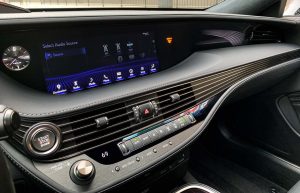
Rearseat legroom has been increased to 38.9 inches and the trunk is now an appropriately sized 17 cubic feet.
Of course, practicality isn’t everything in a top-of-the-line luxury car. Luxury is. Toward that end, this Lexus has almost every conceivable amenity, including ambient interior lighting inspired by Japanese Andon lanterns and “floating” armrests with their own touchscreens for the individualized climate controls.
Mercedes, BMW and Audi have their own brand-specific flourishes along these lines so it’s an opinion call.
Objective differences include the LS500’s massive (24 inch) heads-up display – a feature rivals don’t offer. Instead of a tiny box projected in the the driver’s line of sight, there’s a display larger than some iPads holographically projected ahead of you as you drive.
The HUD lets you keep track of important info without taking your eyes off the road.
Or having to squint to read it.
The optional Mark Levinson audio rig is so good it ought to be standard. In lesser cars, it makes sense to have a so-so or even a “pretty good” stereo as standard – with something better optional. But this is Lexus’ top-of-the-line model and ought to come standard with the best audio rig.
The Rest
Once upon a time, top-of-the-line luxury sedans were to a great extent defined by their V12 and at least V8 engines, which set them apart from the run-of-the-mill. It’s interesting that all of the top-of-the-line players now come with sixes no larger than what’s commonplace in mid-priced family cars – like the Camry, for example.
This has happened because even high-end luxury cars have to do better than 15 MPG – not because people spending close to $100k on a car are particularly sweating the cost of $2.45 per gallon gas – but because of rising CAFE fuel efficiency mandates and the new crop of carbon dioxide “emissions” regulations, which get harder to comply with the larger the engine is.
The happy news is that Lexus, at least, has not only maintained the output of the now-retired V8 but increased it – with a much smaller engine. This is a near-miracle and one can only hope the bubble won’t pop soon.
Gather ye rosebuds while ye may.
The Bottom Line
Characterizing a car this indulgent as sensible sounds ridiculous, but compare what you get vs. what you don’t – for more money – elsewhere.
What worked in ’89 is still working today.
. . .
Got a question about cars – or anything else? Click on the “ask Eric” link and send ’em in!
If you like what you’ve found here please consider supporting EPautos.
We depend on you to keep the wheels turning!
Our donate button is here.
If you prefer not to use PayPal, our mailing address is:
EPautos
721 Hummingbird Lane SE
Copper Hill, VA 24079
PS: Get an EPautos magnet (pictured below) in return for a $20 or more one-time donation or a $5 or more monthly recurring donation. (Please be sure to tell us you want a sticker – and also, provide an address, so we know where to mail the thing!)
My latest eBook is also available for your favorite price – free! Click here. 




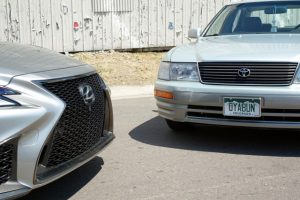
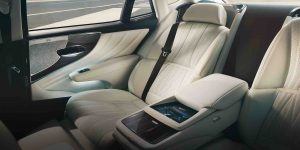

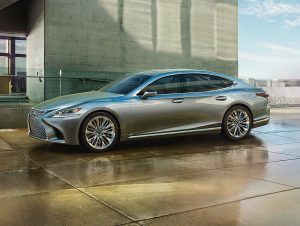
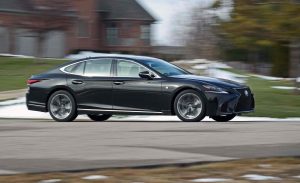
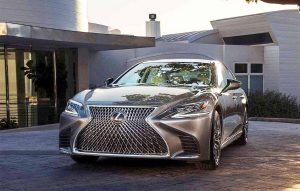
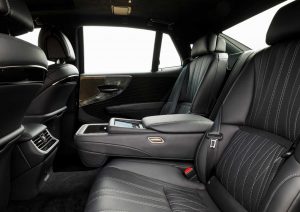








The higher-end Lexus usually have one or more weak points related to the engine or the transmission. Since most people that buy Lexus are loaded, they don’t care when you tell them they need a new transmission or a top-end in the first 5 years.
The V6 which started in the RDX and the V8 which used to be in the LS500 had a common problem where an oil line fails, all oil gets pumped out onto the road, and the car throws a check-engine light about 5 seconds before the engine completely fails.
There were also issues with cooling in the early LS lines which have not been actually fixed. If your Lexus EVER overheats, most models will need new heads at a minimum.
And the amount of transmission failures since 2010 (when all the engine sludge problems were forced to be fixed due to a class-action suit) is epic compared to just about anyone other than Nissan and FCA.
This is a nice car, but it fits into the ‘More money than brains’ category.
Like those bikini models at the car shows, if you hose them down and see what is under the shiny exterior they don’t look very enticing any more.
So i could twin turbo charge a 3.5L v6 camry
Hi Mooeing,
One turbo would be plenty! The stock V6 makes 300-plus horsepower and is as understressed as the Big Lebowski. Goose it with say 21 pounds of boost and I bet it’d make 400 horsepower, easily.
Toyotas are by far the ugliest vehicles on the road. Why do so many these cars lack front bumpers. Look at that Lexus…huge ugly grill, no bumper. Looks like its sucking up leaves. I know this is a subjective call, but as an old neighbor told me when I was just a kid, “beauty is only skin deep, but ugliness runs right to the bone”.
These overstyled cars look great at first but you get tired of the busy-ness of them in 5 years it will be “WTF was I thinking?”
Nice car, and great review as always Eric.
If I was in the $70K price point I would certainly consider this car.
It checks most of my boxes….the most important being RWD, big, powerful.
Why don’t we have choices like this in the $40-50K region from the big three? Only FCA has two models and they are due to go bye-bye so they say.
Thanks, Chris!
I have the new Corolla now as a counterpoint; FWD, small – but something no Corolla has even been until now… fun to drive!
It looks like a giant, glitzy Camry in person. There’s nothing stately about it whatsoever.
Lexus’ swift towards a polarizing design language has only alienated its client base. You know, the ones that can actually afford luxury goods.
Agreed. Lexus seems to following Audi in that regard. Blah.
Take the previous 6th generation Lexus ES (which I’m considering). The 2012-2015 are much better looking than the facelifted 2016-2018 version.
I have occasionally read Lexus reviews in the automotive press, and an almost universal pan they have is Lexus’ bland styling. I always liked their looks, but that’s just me…
OT carbon tax https://scontent-iad3-1.xx.fbcdn.net/v/t1.0-9/56363626_10155721979421653_946490391220191232_n.jpg?_nc_cat=1&_nc_ht=scontent-iad3-1.xx&oh=443f4a025d72d1ee40a1960e163706e2&oe=5D049F1B
Lexus proudly continues its tradition of producing the Ugliest Faces on Any Cars currently offered for sale.
Too bad.
You can buy one from this guy.
https://youtu.be/gmQE4qdb9fg
“Amazon Alexa is now available as a factory option – it’s integrated with the LS500’s Enform concierge system”
Gosh,,, worth it right there!… At least for those that can afford to burn a more than a few ‘C’ notes as in Cleveland.
Nice car for sure…..
That 10 speed transmission delivers basically the same RPMs at highway speeds as the 5 speed transmissions in both my Avalon and my wife’s Highlander, which both have the non-turbo’d ubiquitous 3.5L V6 which Toyota and Lexus have offered for over a decade. They both run 2,100 RPM at an indicated 70 MPH (68 real world MPH).
Apparently that is the sweet spot for fuel economy with these V6s in top gear, regardless of transmissions or body style.